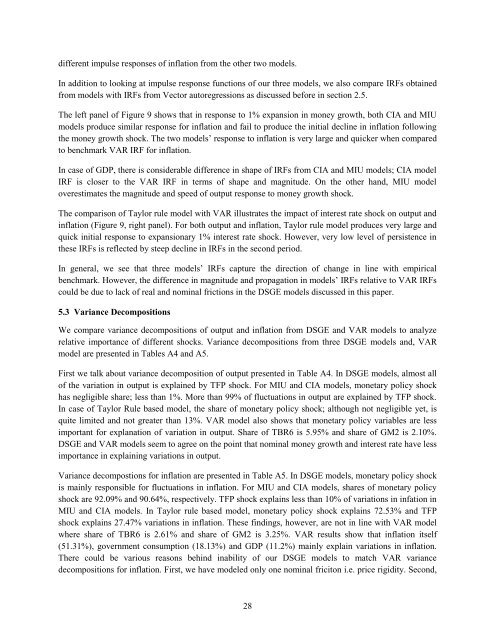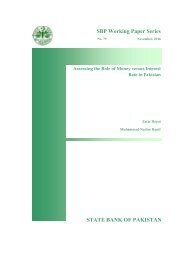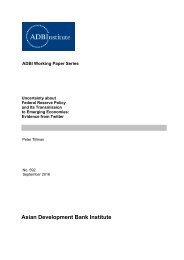SBP Working Paper Series STATE BANK OF PAKISTAN
n?u=RePEc:sbp:wpaper:74&r=mon
n?u=RePEc:sbp:wpaper:74&r=mon
You also want an ePaper? Increase the reach of your titles
YUMPU automatically turns print PDFs into web optimized ePapers that Google loves.
different impulse responses of inflation from the other two models.<br />
In addition to looking at impulse response functions of our three models, we also compare IRFs obtained<br />
from models with IRFs from Vector autoregressions as discussed before in section 2.5.<br />
The left panel of Figure 9 shows that in response to 1% expansion in money growth, both CIA and MIU<br />
models produce similar response for inflation and fail to produce the initial decline in inflation following<br />
the money growth shock. The two models’ response to inflation is very large and quicker when compared<br />
to benchmark VAR IRF for inflation.<br />
In case of GDP, there is considerable difference in shape of IRFs from CIA and MIU models; CIA model<br />
IRF is closer to the VAR IRF in terms of shape and magnitude. On the other hand, MIU model<br />
overestimates the magnitude and speed of output response to money growth shock.<br />
The comparison of Taylor rule model with VAR illustrates the impact of interest rate shock on output and<br />
inflation (Figure 9, right panel). For both output and inflation, Taylor rule model produces very large and<br />
quick initial response to expansionary 1% interest rate shock. However, very low level of persistence in<br />
these IRFs is reflected by steep decline in IRFs in the second period.<br />
In general, we see that three models’ IRFs capture the direction of change in line with empirical<br />
benchmark. However, the difference in magnitude and propagation in models’ IRFs relative to VAR IRFs<br />
could be due to lack of real and nominal frictions in the DSGE models discussed in this paper.<br />
5.3 Variance Decompositions<br />
We compare variance decompositions of output and inflation from DSGE and VAR models to analyze<br />
relative importance of different shocks. Variance decompositions from three DSGE models and, VAR<br />
model are presented in Tables A4 and A5.<br />
First we talk about variance decomposition of output presented in Table A4. In DSGE models, almost all<br />
of the variation in output is explained by TFP shock. For MIU and CIA models, monetary policy shock<br />
has negligible share; less than 1%. More than 99% of fluctuations in output are explained by TFP shock.<br />
In case of Taylor Rule based model, the share of monetary policy shock; although not negligible yet, is<br />
quite limited and not greater than 13%. VAR model also shows that monetary policy variables are less<br />
important for explanation of variation in output. Share of TBR6 is 5.95% and share of GM2 is 2.10%.<br />
DSGE and VAR models seem to agree on the point that nominal money growth and interest rate have less<br />
importance in explaining variations in output.<br />
Variance decompostions for inflation are presented in Table A5. In DSGE models, monetary policy shock<br />
is mainly responsible for fluctuations in inflation. For MIU and CIA models, shares of monetary policy<br />
shock are 92.09% and 90.64%, respectively. TFP shock explains less than 10% of variations in infation in<br />
MIU and CIA models. In Taylor rule based model, monetary policy shock explains 72.53% and TFP<br />
shock explains 27.47% variations in inflation. These findings, however, are not in line with VAR model<br />
where share of TBR6 is 2.61% and share of GM2 is 3.25%. VAR results show that inflation itself<br />
(51.31%), government consumption (18.13%) and GDP (11.2%) mainly explain variations in inflation.<br />
There could be various reasons behind inability of our DSGE models to match VAR variance<br />
decompositions for inflation. First, we have modeled only one nominal friciton i.e. price rigidity. Second,<br />
28






